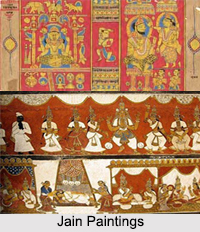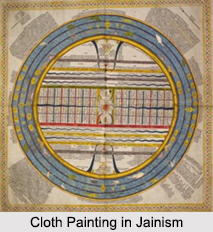 Jain Painting in ancient India was a favourite model of expression in art. The Jain community has made a great contribution to the growth and development of this art. The art of Jain Painting had reached a high degree of excellence both from the technical and aesthetic points of view. Literary sources mention guilds of painters, who decorated palaces and temples with the best wall paintings. But, with the passage of time, the destructible nature of materials like palm-leaf, cloth, plaster and the vandalism of human beings have caused their destruction to such an extent that the examples of ancient Jain Paintings are limited. The best examples of Jain paintings are the wall-paintings of Ajanta, Bagh, Sittannavasal and Badami.
Jain Painting in ancient India was a favourite model of expression in art. The Jain community has made a great contribution to the growth and development of this art. The art of Jain Painting had reached a high degree of excellence both from the technical and aesthetic points of view. Literary sources mention guilds of painters, who decorated palaces and temples with the best wall paintings. But, with the passage of time, the destructible nature of materials like palm-leaf, cloth, plaster and the vandalism of human beings have caused their destruction to such an extent that the examples of ancient Jain Paintings are limited. The best examples of Jain paintings are the wall-paintings of Ajanta, Bagh, Sittannavasal and Badami.
Jain Wall Paintings
Early Jain paintings are found in the caves at Udayagiri and Khandagiri in Odisha. But the earliest documented Jain paintings are the wall paintings at Sittannavasal attributed to Mahendra Varman I (600-625 A.D.). The walls and ceilings of Sittannavasal were once fully covered with paintings of which only a few have survived, like figures of Apsaras dancing in the clouds, a royal couple and two lotus ponds.
Jain Miniature Paintings on Palm-Leaf and Paper
Some of the Jain scriptures display beautiful miniature paintings on Palm-leaf, birch-bark and paper. Palm-leaf and Birch-bark were extensively used as writing materials, between 1060 A.D. and 1350 A.D. before the advent of paper in India. The earliest examples of Jain miniature paintings are the palm-leaf manuscripts of the sacred texts "Ogha Niryukti" and "Dasavaikalika Tika", dated 1060 A.D., which depict incense burner, lotus, figures of elephants and lion and Lakshmi seated in Padmasana. These manuscripts represent Western- Indian style of painting. In Mulabidri Digambara Jain Bhandar, the first three illustrated manuscripts of "Satkhandagama", "Mahabandha" and "Kasaya Pahuda" written in 1113 A.D. to 1120 A.D. are displayed.
In these manuscripts red, blue and yellow colours are used more frequently than others. Gold and silver colours were also used for borders. The script was written generally with black or red colour. The most favorite themes painted were lives of the Tirthankaras and their past births, as they are the most adorable figures in Jainism.
 These manuscripts are store houses of information. Apart from the religious teachings, they also give us the knowledge of society, economy, flora and fauna, food, clothing, architecture, habits, the whole culture prevailing during a particular period.
These manuscripts are store houses of information. Apart from the religious teachings, they also give us the knowledge of society, economy, flora and fauna, food, clothing, architecture, habits, the whole culture prevailing during a particular period.
Jain Miniature Paintings on Paper
With the advent of paper, writing and painting on palm-leaf declined. Jains also started using paper for writing and illustrating the sacred literature in the 13th century A.D. One of the most favorite texts was "Kalpa Sutra", as it described the lives of all the Tirthankaras, which was the popular trend at that time."Kalakacharya Kathanaka" of Kalpa Sutra also was frequently painted. Other examples of paper miniatures are "Trisasthisalakapurusa Charitra" of Hemachandracharya, "Santinatha Charitra", "Ajitanatha Charitra", etc.
Painted Wooden Book-Covers
Painted wooden book-covers were used for covering the palm-leaf and paper manuscripts on the front and the back side, for protection. These book-covers were decorated with floral borders, symbols, animals and geometric designs. Figures of the Tirthankaras, Gods and Goddesses were also favorite subjects for Jain paintings.
Jain Cloth Paintings
Jain Cloth Paintings are found in museums and Jain libraries. Due to the perishable nature of cloth, very few have survived. The Jain structure of the Universe and Tirtha Kshetras were popular themes painted on cloth. "Vijnapti Patras" (invitation letters) are also beautiful examples of Jain cloth paintings. These are illustrated scrolls of invitations sent to Jain Acharyas by the Jain community of a town or village, requesting them to spend the next rainy season in their village. In these Patras one finds a map of that village and the routes to reach the destination. Sometimes village scenes are also drawn.




















